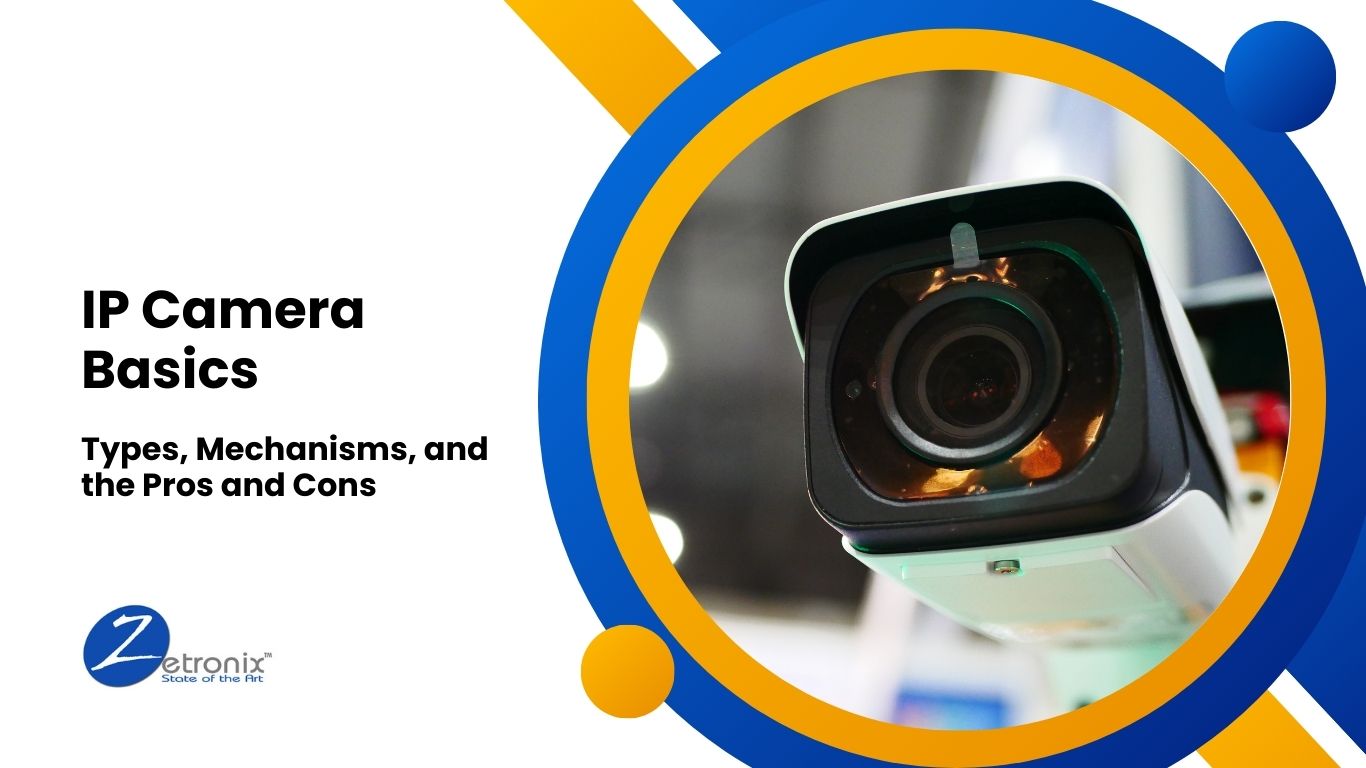What is an IP Camera: Understanding Its Types, Working, and Pros/Cons

Do you know what IP cameras are? IP Cameras, also known as Internet Protocol or Network Cameras, are an integral partof security solutions for both residential and commercial areas. These cameras offer advanced features and functionalities, making them a go-to for many.
In this guide, we aim to understand what IP cameras are. Look into their types and how they work, as well as the pros and cons they have to offer.
What is an IP Camera?

Let’s begin by understanding what an IP Camera is. Internet Protocol (IP) cameras are digital video cameras that transmit and receive footage over the Internet or a local area network (LAN). They are nothing like traditional analog cameras, which need a digital video recorder (DVR) or a monitor. IP cameras work independently and are connected to the network wirelessly or through a PoE (power over Ethernet) cable. Since they are connected to the Internet or a local network, they allow you to access the footage from anywhere.
IP Camera: How Does it Work?
Now that we know the answer to the question of what an IP Camera is let's figure outhow it works. These cameras work by converting analog video signals into digital video signals, which are then compressed and transmitted over an IP network. Confused? Let’s break this down into simpler steps and understand how an IP camera works:
Step 1: Capturing the Image
IP Cameras start by capturing a video using an image sensor. The image sensors usually used in these cameras are either CMOS or CCD sensors. Now, what do these sensors do? They convert light into electrical signals, meaning the visual information is converted into electronic information. The captured video is then processed by the internal components of the camera to produce a digital image.
Step 2: Compression
Once the videos are converted into a digital format, they are compressed. Compression is necessary to reduce the size of the video files. Reduction in the size of the video not only makes it easier to be transmitted over the network but also minimizes the storage requirements.
IP cameras use various compression algorithms or codecs, including H.264 or H.265, to compress the video without compromising the quality of the image. These codecs analyze the video frames and remove unwanted information while keeping essential information, significantly reducing the file size.
Step 3: Transmission
Now that the video is compressed, it is transmitted over a network. This network can either be wired or wireless, and the nature of the network depends on the camera's connectivity options. Wired cameras are connected via an ethernet cable or network switch, providing stable and reliable data transmission options. On the other hand, wireless cameras are connected via a Wi-Fi or cellular network, so you can place the cameras anywhere you want. No matter what type of connection is used, the video footage is either sent to a central recording device or network video recorder (NVR).
Step 4: Storage and Playback
Once the video footage reaches the network video recorder, it is stored on the device’s hard drive or cloud storage. An NVR is like a single storage device that stores video footage from various IP Cameras. Moreover, it lets users access footage from anywhere and at any time, allowing them to view recorded footage, live streams, or change camera settings—all you need is an internet connection.
Furthermore, some IP cameras also come with local storage devices, such as a microSD card, so your camera can store the footage locally if there is a connectivity issue.
The HIDIX - 1080p Wireless Magnetic Mini Camera from Zetronix lets you save 264 hours of footage on 64 GB and also accepts a microSD card to store videos locally in case of a connectivity issue.
Types of IP Cameras:

There are different types of IP cameras available in the market, each designed to meet your specific needs. Here is a list of cameras available in the market that you can use for your surveillance needs.
Fixed IP Cameras:
As suggested by the name, Fixed IP Cameras have a stationary lens that offers a fixed field of view. Such cameras are ideal for monitoring fixed areas, such as parking lots, hallways, or entrances.
PTZ IP Cameras:
PTZ (pan-tilt-zoom) IP Cameras give the user remote control over the camera's movement so that the user can pan, tilt, and zoom to capture the footage from various angles. These cameras are used in large areas such as stadiums and industrial facilities for comprehensive coverage.
Get your hands on the XS7 Pro - HD Wi-Fi Solar Powered Rotating Security Surveillance Camera from Zetronix, giving you a 360° Pan With 180° Tilt, which you can easily adjust using your smartphone.
Wireless IP Cameras:
Wireless IP Cameras offer flexibility in placement and installation as they are connected to a network wirelessly, i.e., via a Wi-Fi network. These cameras are best for places where running cables is challenging, such as the HIDIX 4G - 1080p 4G LTE Wireless Mini Camera, which offers wireless surveillance solutions.
Outdoor IP Cameras:
Sometimes, you need to keep the outdoors secure as well. This is where outdoor security cameras come in. They are designed to withstand harsh weather conditions, are waterproof, and can work in extreme temperatures.
Check out ZYMI—1080p Waterproof Long Battery Life Mini Camera for your outdoor security needs.
Solar Powered IP Cameras:
Looking for eco-friendly and cost-effective surveillance solutions? Look no further than solar-powered IP cameras. These solar outdoor cameras offer you the flexibility of placement at remote locations where you don’t have a power supply. These cameras come built-in with solar panels and rechargeable batteries. For solar-powered solutions, have a look at X10 Pro - Solar Powered Wi-Fi Ultrabright Floodlight Solar Camera from Zetronix.
Hidden Cameras:
Hidden Cameras are usually disguised as every object, such as an alarm clock, picture frame, dummy smoke detectors, etc. They blend in with the surroundings so you can keep an eye on your loved ones without anyone knowing. Looking for a hidden camera for added security? Check out Rhea - 2K Digital Picture Frame Nanny Camera or Ares - 1080p WIFI Nanny Camera Alarm Clock with IR Night Vision from Zetronix.
IP Cameras Installation & Configuration:

IP camera installation and configuration involves the following steps.
- Selecting the Right Camera: Choose the appropriate type of camera for your surveillance needs.
- Mounting: Install the camera at the desired location, ensuring proper alignment and coverage of the area to be monitored.
- Network Configuration: Connect the camera to a network using either Wi-FI or a cable. Moreover, configure network settings, including IP address and subnet mask.
- Power Supply: Depending on your camera's needs, you can either add or charge batteries or connect to a power supply.
- Software Setup: Install your camera’s related software app on your computer or smartphone to access stored or live footage and manage camera settings.
- Testing: Lastly, test if your camera is working properly; check all its features, including video feed, motion detection, and remote access.
Pros and Cons of IP Cameras:
To determine why IP cameras are the best choice for you, let’s have a look at the various pros and cons:
Pros:
- With IP cameras, you can access high-definition video quality, enabling clearer and more detailed surveillance.
- These cameras offer convenience and flexibility, letting you stream and record footage from anywhere and at any time with just an internet connection.
- Get advanced security features with IP cameras, such as motion detection, night vision, and two-way audio communication.
- You can easily expand your IP surveillance system by adding more cameras.
- Although initial setup may be costly, in the long term, it is cost-effective, reducing maintenance and cabling expenses.
Cons:
- IP cameras use bandwidth on the network, resulting in slower internet speed.
- Since these cameras are connected to the internet, they are vulnerable to hacking and cybersecurity threats.
- Setting up an IP camera system requires technical expertise and knowledge.
- IP Cameras need a stable power source and network connection, making them vulnerable to outages.
Experience Advanced Surveillance Capabilities with Zetronix:
Get your hands on advanced surveillance capabilities with IP cameras. By understanding how IP cameras work, their different types, and their pros and cons, you can make an informed decision for your security needs.
For high-quality outdoor surveillance solutions, explore Zetronix's range of solar outdoor cameras and hidden cameras today!
FAQs:
Q: Which type of wire is used for IP cameras?
IP cameras usually use an ethernet cable that connects it to a network and supplies it with power as well.
Q: Can I use an IP camera without NVR?
Yes, you can use an IP camera without an NVR. All you have to do is connect them to a computer or a network storage device and use dedicated software for recording and management.
Q: How to reset the IP camera without the reset button?
You can usually reset a camera without a reset button through its app. The settings in the camera’s app would have a reset option.




